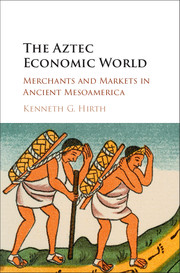Book contents
- Frontmatter
- Contents
- List of figures
- List of tables
- Preface
- Abbreviations
- 1 Introduction to the Aztec economic world
- 2 The structure of Mesoamerican economy
- 3 The Mesoamerican marketplace
- 4 Merchants, profit, and the precolumbian world
- 5 Often invisible: domestic entrepreneurs in Mesoamerican commerce
- 6 The professional retail merchants
- 7 Merchant communities and pochteca vanguard merchants
- 8 The tools of the trade and the mechanics of commerce
- 9 Conclusions
- Notes
- Glossary of Nahuatl and early colonial Spanish terms
- Bibliography
- Index
6 - The professional retail merchants
Published online by Cambridge University Press: 05 May 2016
- Frontmatter
- Contents
- List of figures
- List of tables
- Preface
- Abbreviations
- 1 Introduction to the Aztec economic world
- 2 The structure of Mesoamerican economy
- 3 The Mesoamerican marketplace
- 4 Merchants, profit, and the precolumbian world
- 5 Often invisible: domestic entrepreneurs in Mesoamerican commerce
- 6 The professional retail merchants
- 7 Merchant communities and pochteca vanguard merchants
- 8 The tools of the trade and the mechanics of commerce
- 9 Conclusions
- Notes
- Glossary of Nahuatl and early colonial Spanish terms
- Bibliography
- Index
Summary
Professional retail merchants also existed in prehispanic society. Two features distinguish retail merchants from the producer-sellers discussed previously. First, these merchants engaged in commerce on a full-time basis as the primary means of earning their livelihood. While some producer-sellers may have practiced their trade on a full-time basis, most did not. Second, many of these merchants were retailers in the modern sense; they bought or procured goods from others for resale at a profit. Although it may seem cumbersome to apply this modern terminology to prehispanic merchants, it is useful to do so because it identifies their role within the production-distribution network in terms that are compatible with their modern and premodern counterparts elsewhere in the world. Did merchants act as intermediary resellers at multiple levels in the distribution chain or did they obtain goods directly from producers for resale to consumers? Answering this question will clarify the structure of prehispanic economic relationships across the Aztec economic world.
Retail venders appear to have been a regular feature of both permanent and periodic prehispanic marketplaces. They had assigned locations in the large daily markets of Tlatelolco, Tenochtitlan, and Tlaxcala. While they were not shopkeepers in the sense that this institution developed in the early colonial period, they were regular outlets for the goods they sold to consumers. Identifying who these retailers were is a difficult task. Nevertheless, there are indications for thirty-nine classes of retailers in the sources as well as individuals at the fuzzy margins of retailing that include producer-sellers who engaged in small-scale retailing as an auxiliary activity.
The presence of retail activity raises the problematical issue of how merchants obtained the goods they resold. Retail selling is dependent upon two conditions: the presence of differential pricing structure and the development of a supply chain or procurement network through which goods were mobilized. The development of a commodity supply chain was a critical step in the evolution of a commercial system from one centered on producer-sellers who sold small quantities of specialized goods, to one involving more diversified retailing. To address this issue, three forms of commodity acquisition are examined and evaluated: contact acquisition, mobile procurement, and brokerage acquisition.
- Type
- Chapter
- Information
- The Aztec Economic WorldMerchants and Markets in Ancient Mesoamerica, pp. 151 - 187Publisher: Cambridge University PressPrint publication year: 2016
- 1
- Cited by



